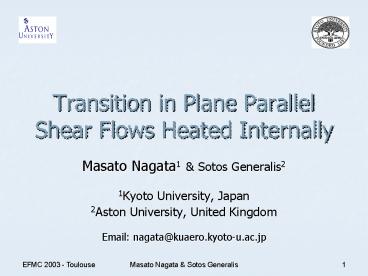Transition in Plane Parallel Shear Flows Heated Internally
1 / 20
Title:
Transition in Plane Parallel Shear Flows Heated Internally
Description:
Stability of Secondary Flow Bifurcation points for tertiary flow ... Poloidal and toroidal parts of the velocity fluctuations and temperature deviations ... –
Number of Views:30
Avg rating:3.0/5.0
Title: Transition in Plane Parallel Shear Flows Heated Internally
1
Transition in Plane Parallel Shear Flows Heated
Internally
- Masato Nagata1 Sotos Generalis2
- 1Kyoto University, Japan
- 2Aston University, United Kingdom
- Email nagata_at_kuaero.kyoto-u.ac.jp
2
Overview
- Motivation
- Introduction
- Basic Equations
- Linear Stability
- Secondary Flow
- Stability of Secondary Flow Bifurcation points
for tertiary flow - Conclusions and Future work
3
Motivation
- Behaviour of the Earths mantle
- Nuclear Reactor Design Safety aspects
- Recent studies in various geometries and boundary
arrangements in turbulent regime appropriate to
nuclear reactor safety - Examine bifurcation behaviour of strongly
non-linear equilibrium solutions from laminar
state to turbulent state Stability of Flow - Employ recently developed techniques
4
Introduction
Geometrical configuration exhibiting the basic
flow profile with two inflection points in an
inclined layer internal heat source q.
5
Introduction
- Apply Boussinesq approximation for fluid bounded
between two parallel plates at TT0
6
Introduction
- Non-dimensional description
- Length d
- Time d2/?
- Temperature qd2/2?Gr
- Physical properties are described by
non-dimensional parameters - Gr gßqd5/2??2 Grashof Number
- R Umaxd/ ? Reynolds Number
- Pr ?/ ? Prandtl Number
- Umax Maximum Laminar Velocity
7
Introduction
8
Introduction
- Basic Flow that satisfies fixed temperature
T00 and no-slip u0 at z1
9
Basic Equations
- Introduce velocity and temperature disturbances1
- 1M.Nagata S.Generalis,JHT,v124,p634 2002
- S.Generalis M.Nagata, JHT, in press 2003
- S.Generalis M.Nagata, Eurotherm 74, Heat
Transfer in Unsteady Flows p1172003 - M. Nagata S.Generalis, Comptes Rendus Mecanique
submitted 2003
10
Basic Equations
Poloidal and toroidal parts of the velocity
fluctuations and temperature deviations
11
Basic Equations
12
Basic Equations
13
Linear Stability (TW type disturbances)
- Ignore non-linear terms in fluctuations
- Ignore mean flow and temperature
- Identify maximum Grashof for laminar flow
- Travelling wave (TW) disturbances of the form
(Squires theorem)
14
Linear Stability (LR type disturbances)
- Ignore non-linear terms in fluctuations
- Ignore mean flow and temperature
- Identify maximum Grashof for laminar flow
- Longitudinal Roll (LR) disturbances of the
- form
15
Linear Stability (TW and LR type disturbances)
- Critical Grashof number as a function of angle
of inclination for LRs continous curve and TWs
dash-dotted curves. Pr7,R0.
16
Secondary Flow - LRs
- Newton-Raphson combined with Chebyshev
collocation point method Pr7, R0
17
Secondary Flow - LRs
- Total Mean Flow for R0, Pr7. B represents the
basic flow contribution.
18
Stability of Secondary Flow
- Infinitesimal 3-D disturbances are
superimposed on 2-D equilibrium solution
identify bifurcation for tertiary flow - truncation level same as for steady solution
19
Stability of Secondary Flow - LRs
- Instability boundaries of secondary LRs for
Pr 0, R0. The dashed curve represents the
linear neutral curve.
20
Conclusions and Future Work
- Stability of incompressible flow in an inclined
uniformly heated channel - Linear various Pr, R stability infinitesimal
disturbances Hopf bifurcation -streamwise -
transverse TWs and spanwise LRs - Secondary Flow - Stability of Secondary LRs
- General 3-D disturbance- Angle of Inclination
- Competing Instabilities
- Realistic case constant flux condition































